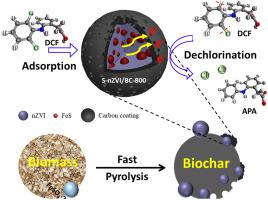Journal of Environmental Chemical Engineering ( IF 7.4 ) Pub Date : 2021-04-02 , DOI: 10.1016/j.jece.2021.105425 Bu-De Xu , Ting-Ting Qian , Shuo Chen , Jing Yang , Hong Jiang

|
Sulfide-modified nanoscale zero-valent iron (S-nZVI) is a commonly used reductive agent in pollutant removal. However, the aggregation of S-nZVI can lower its reduction capacity in the water, and its regeneration remains challenging. To overcome these limitations, one-pot fast pyrolysis of FeSO4-loaded lignocellulosic biomass was proposed to obtain highly stable biochar-supported S-nZVI (S-nZVI/BC) nanoparticles. During this process, Fe2+ were reduced and sulfuretted in situ to form S-nZVI and subsequently covered by the freshly formed carbon film. A series of S-nZVI/BCs pyrolyzed at different temperatures (500-1000°C) were prepared, among which S-nZVI/BC pyrolyzed at 800 oC (S-nZVI/BC-800) exhibited a fast and stable removal of diclofenac (DCF) via adsorption and reduction. The DCF removal efficiency of S-nZVI/BC-800 reached 80.1% within 4 h, with a particle dosage of 0.5 g/L and Fe dosage of 1 mmol/g. The adsorption and reduction efficiencies of DCF by S-nZVI/BC-800 were 43.2% and 36.9%, respectively. The improved reactivity of S-nZVI/BC-800 can be attributed to the formation of iron sulfides (i.e., FeS and Fe1−xS) in ZVI particles, which increased the electrical conductivity and improved the material selectivity for the reduction of DCF in the water. S-nZVI/BC-800 could be easily regenerated through pyrolysis, during which the carbon film could act as the electron donor. This study provides a facile and skillful method to prepare a highly stable and refreshable S-nZVI, which could be a promising permeable reactive bed material for the remediation of halogenated organic pollutants in contaminated water.
中文翻译:

通过一锅快速热解法制备高度稳定且易于再生的磺化nZVI以去除双氯芬酸
硫化物改性的纳米零价铁(S-nZVI)是污染物去除中常用的还原剂。然而,S-nZVI的聚集会降低其在水中的还原能力,并且其再生仍然具有挑战性。为了克服这些限制,提出了一锅法快速热解负载FeSO 4的木质纤维素生物质,以获得高度稳定的生物炭负载S-nZVI(S-nZVI / BC)纳米粒子。在此过程中,Fe 2+被还原并原位硫化,形成S-nZVI,随后被新形成的碳膜覆盖。/制备在不同的温度(500-1000℃)下热解的BC一系列S-的nZVI的,其中的S-的nZVI / BC热解在800 Ô C(S-nZVI / BC-800)具有吸附和还原作用,可快速,稳定地去除双氯芬酸(DCF)。S-nZVI / BC-800的DCF去除率在4 h内达到80.1%,颗粒剂量为0.5 g / L,Fe剂量为1 mmol / g。S-nZVI / BC-800对DCF的吸附和还原效率分别为43.2%和36.9%。S-nZVI / BC-800反应活性的提高可归因于硫化铁的形成(即FeS和Fe 1-xSVI)在ZVI颗粒中,这增加了电导率并提高了材料选择性以减少水中的DCF。S-nZVI / BC-800可以通过热解容易地再生,在此期间碳膜可以充当电子给体。这项研究为制备高度稳定和可更新的S-nZVI提供了一种简便而熟练的方法,它可能是一种有前途的可渗透反应床材料,用于修复污水中的卤代有机污染物。











































 京公网安备 11010802027423号
京公网安备 11010802027423号